Satavahana dynasty
The Satavahanas, Sādavāhana or Sātavāhana,[2] IAST: Sātavāhana), also referred to as the Andhras in the Puranas, were an ancient Indian dynasty based in the Deccan region. Most modern scholars believe that the Satavahana rule began in the late second century BCE and lasted until the early third century CE, although some assign the beginning of their rule to as early as the 3rd century BCE based on the Puranas, but uncorroborated by archaeological evidence.[3] The Satavahana kingdom mainly comprised the present-day Telangana, Andhra Pradesh and Maharashtra. At different times, their rule extended to parts of modern Gujarat, Madhya Pradesh, and Karnataka. The dynasty had different capital cities at different times, including Pratishthana (Paithan) and Amaravati (Dharanikota).
Satavahana Empire (Andhras) | |||||||||||||||||||
|---|---|---|---|---|---|---|---|---|---|---|---|---|---|---|---|---|---|---|---|
| Late 2nd century BCE–Early 3rd century CE | |||||||||||||||||||
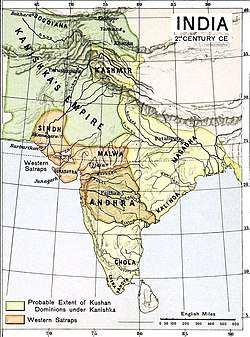 Approximate extent of the Satavahana (Andhra) Empire under Gautamiputra Satkarni (in brown), in the 2nd century CE | |||||||||||||||||||
| Capital | Pratishthana, Amaravati | ||||||||||||||||||
| Common languages | Prakrit, Sanskrit | ||||||||||||||||||
| Religion | Hinduism, Buddhism | ||||||||||||||||||
| Government | Monarchy | ||||||||||||||||||
| Emperor | |||||||||||||||||||
| Historical era | Classical India | ||||||||||||||||||
• Established | Late 2nd century BCE | ||||||||||||||||||
• Disestablished | Early 3rd century CE | ||||||||||||||||||
| |||||||||||||||||||
| Today part of | India[1] | ||||||||||||||||||
| Satavahana Empire 100 BCE–2nd c. CE | ||||||||||||||||||||||
|---|---|---|---|---|---|---|---|---|---|---|---|---|---|---|---|---|---|---|---|---|---|---|
|
||||||||||||||||||||||
The origin of the dynasty is uncertain, but according to the Puranas, their first king overthrew the Kanva dynasty. In the post-Maurya era, the Satavahanas established peace in the Deccan region, and resisted the onslaught of foreign invaders. In particular their struggles with the Saka Western Satraps went on for a long time. The dynasty reached its zenith under the rule of Gautamiputra Satakarni and his successor Vasisthiputra Pulamavi. The kingdom fragmented into smaller states by the early 3rd century CE.
The Satavahanas were early issuers of Indian state coinage struck with images of their rulers. They formed a cultural bridge and played a vital role in trade and the transfer of ideas and culture to and from the Indo-Gangetic Plain to the southern tip of India. They supported Hinduism as well as Buddhism, and patronised Prakrit literature.
Origins
The date and place of origin of the Satavahanas, as well as the meaning of the dynasty's name, are a matter of debate among the historians. Some of these debates have happened in the context of regionalism, with the present-day Andhra Pradesh, Maharashtra, Karnataka and Telangana being variously claimed as the original homeland of the Satavahanas.[4]
Etymology
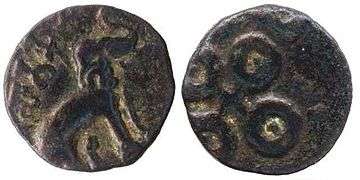
According to one theory, the word "Satavahana" (Brahmi script: 𑀲𑀸𑀤𑀯𑀸𑀳𑀦 Sādavāhana or 𑀲𑀸𑀢𑀯𑀸𑀳𑀦 Sātavāhana,[2] IAST: Sātavāhana) is a Prakrit form of the Sanskrit Sapta-Vahana ("driven by seven"; in Hindu mythology, the chariot of the sun god is drawn by seven horses). This would indicate that the Satavahanas originally claimed association with the legendary solar dynasty, as was common in ancient India.[6] According to Inguva Kartikeya Sarma, the dynasty's name is derived from the words sata ("sharpened", "nimble" or "swift") and vahana ("vehicle"); the expression thus means "one who rides a nimble horse".[7]
Another theory connects their name to the earlier Satiyaputa dynasty. Yet another theory derives their name from the Munda words Sadam ("horse") and Harpan ("son"), implying "son of the performer of a horse sacrifice".[8] Several rulers of the dynasty bear the name or title "Satakarni". Satavahana, Satakarni, Satakani and Shalivahana appear to be variations of the same word. Damodar Dharmanand Kosambi theorised that the word "Satakarni" is derived from the Munda words sada ("horse") and kon ("son").[9]
The Puranas use the name "Andhra" for the Satavahanas. The term "Andhra" may refer to ethnicity or territory of the dynasty (see Original homeland below). It does not appear in the dynasty's own records.[10]
Tamil epic Silappatikaram mentions a "Nurruvar Kannar", who helped Chera king Senguttuvan during his Himalaya campaign. The direct translation of the term Nurruvar Kannar is "the hundred Karnas" or "Satakarni", hence the Nurruvar Kannar has been identified with the Satavahana dynasty.[11][12][13]
Original homeland
The use of the names "Andhra" and "Andhra-Jatiya" in the Puranas has led some scholars, such as E.J Rapson and R.G Bhandarkar, to believe that the dynasty originated in the eastern Deccan region (the historic Andhra region, present-day Andhra Pradesh and Telangana).[17][18] At Kotilingala in Telangana, coins bearing the legend "Rano Siri Chimuka Satavahanasa" were found.[19] Epigraphist and numismastist P. V. P. Sastry initially identified Chimuka with the dynasty's founder Simuka,[20] because of which Kotilingala came to be known as the only place where coins attributed to Simuka were found. Coins attributed to Simuka's successors Kanha and Satakarni I were also discovered at Kotilingla.[21] Based on these discoveries, historians such as Ajay Mitra Shastri, D. R. Reddy, S. Reddy and Shankar R. Goyal theorised that Kotlingala was the original home of the Satavahanas. Ajay Mitra Shastri stated that the finding of the coins at Kotilinga give "a clear pointer to the region where we have to locate the original center of the Satavahana political authority."[22] However, the coin samples from Kotlingala are small, and it is not certain if these coins were minted there or reached there from somewhere else.[23] Moreover, the identification of Chimuka of Kotilingala with the dynasty's founder Simuka has been contested by several scholars including P. L. Gupta and I. K. Sarma, who identified Chimuka as a later ruler.[24][25] P.V.P. Sastry also later changed his view, and stated that the two kings were different.[20] In addition to the Kotilinga find, a coin of the Satavahana prince Saktikumara, who was in the fourth generation of the founder, has been reported as a stratified find from the Kurnool district of Andhra Pradesh.[22] As for the Puranas, these texts could have been compiled at a later date and it is not certain if the Satavahanas were referred to as Andhras during their time.[25][26]
Another section of scholars believe that the Satavahanas originated in western Deccan (present-day Maharashtra).[17] All four extant inscriptions from the early Satavahana period (c. 1st century BCE) have been found in and around this region. Until recently the earliest known Satavahana inscription was that found at Cave No.19 of the Pandavleni Caves in Nashik district, which was issued during the reign of Kanha (100-70 BCE),[27] however the most recent research shows the oldest Satavahana inscription is the one found on a slab of the upper drum (medhi) of the Kanaganahalli mahastupa mentioning year 16 of Vasisthiputra Sri Chimuka Satavahana's reign, which can be dated from ca. 110 BCE.[28][29][30] An inscription found at Naneghat was issued by Nayanika (or Naganika), the widow of Satakarni I; another inscription found at Naneghat has been dated to the same period on a paleographic basis. A slightly later inscription dated to the reign of Satakarni II has been found at Sanchi in Madhya Pradesh, located to the north of Maharashtra.[4] The majority of the other Satavahana inscriptions have also been found in western Deccan.[23] On the other hand, the epigraphic evidence from eastern Deccan does not mention the Satavahanas before the 4th century CE.[25] At Nevasa, a seal and coins attributed to Kanha have been discovered.[31] Coins attributed to Satakarni I have also been discovered at Nashik, Nevasa and Pauni in Maharashtra (besides places in eastern Deccan and present-day Madhya Pradesh).[19] Based on this evidence, some historians argue that the Satavahanas initially came to power in the area around their capital Pratishthana (modern Paithan, Maharashtra) and then expanded their territory to eastern Deccan.[32] Carla Sinopoli cautions that the inference about the western Deccan origin of the Satavahanas is "tentative at best" given the small sample of early inscriptions.[33]
𑀲𑀸𑀤𑀯𑀸𑀳𑀦𑀓𑀼𑀮𑁂 𑀓𑀦𑁆𑀳𑁂𑀭𑀸𑀚𑀺𑀦𑀺 𑀦𑀸𑀲𑀺𑀓𑁂𑀦
𑀲𑀫𑀡𑁂𑀦 𑀫𑀳𑀸𑀫𑀸𑀢𑁂𑀡 𑀮𑁂𑀡 𑀓𑀸𑀭𑀢
Sādavāhanakule Kanhe rājini Nāsikakena Samaṇena mahāmāteṇa leṇa kārita
"Under King Kanha of the Satavahana family this cave has been caused to be made by the officer in charge of the Sramanas at Nasik".[2] However the most recent research shows the oldest Satavahana inscription is the one found on a slab of the upper drum (medhi) of the Kanaganahalli mahastupa mentioning year 16 of Vasisthiputra Sri Chimuka Satavahana's reign, which can be dated from ca. 110 BCE.[28][29][30]
Kanha's Pandavleni mentions the term maha-matra (officer-in-charge), which indicates that the early Satavahanas followed the Mauryan administrative model.[34] C. Margabandhu theorised that the Satavahanas were called Andhras because they were natives of eastern Deccan (the Andhra region), although they first established their empire in western Deccan after having served as Mauryan subordinates. Himanshu Prabha Ray (1986) opposes this theory, stating that the Andhra was originally an ethnic term, and did not come to denote the geographical region of eastern Deccan until well after the Satavahana period.[4] According to Vidya Dehejia, the writers of the Puranas (which could have been written after the Satavahana period) mistook the Satavahana presence in eastern Deccan as evidence for their origin in that region, and wrongly labelled them as "Andhra".[35]
Some scholars also suggest that the dynasty originated in present-day Karnataka, and initially owed allegiance to some Andhra rulers.[36] V. S. Sukthankar theorised that the territorial division Satavahani-Satahani (Satavahanihara or Satahani-rattha), in present-day Bellary district, was the homeland of the Satavahana family.[37] However, Dr. Gopalchari challenged Sukthankar's theory by pointing out that not a single inscription of the early Satavahanas is found in Bellary District and that the only Satavahana inscription in Bellary District was that of Pulumavi, who belongs to the later-phase of Satavahana history.[38] A stupa in Kanaganahalli village of Karnataka, dated between the first century BCE and first century CE, features limestone panels depicting portraits of Chimuka (Simuka), Satakani (Satakarni) and other Satavahana rulers.[39]
History
Information about the Satavahanas comes from the Puranas, some Buddhist and Jain texts, the dynasty's inscriptions and coins, and foreign (Greek and Roman) accounts that focus on trade.[40] The information provided by these sources is not sufficient to reconstruct the dynasty's history with absolute certainty. As a result, there are multiple theories about the Satavahana chronology.[41]
Foundation
Simuka is mentioned as the first king in a list of royals in a Satavahana inscription at Naneghat. The various Puranas state that the first king of the dynasty ruled for 23 years, and mention his name variously as Sishuka, Sindhuka, Chhismaka, Shipraka, etc. These are believed to be corrupted spellings of Simuka, resulting from copying and re-copying of manuscripts.[42] Simuka cannot be dated with certainty based on available evidence. Based on the following theories, the beginning of the Satavahana rule is dated variously from 271 BCE to 30 BCE.[43] According to the Puranas, the first Andhra king overthrew the Kanva rule. He is named as Balipuccha in some texts.[44] D. C. Sircar dated this event to c. 30 BCE, a theory supported by many other scholars.[41]
The Matsya Purana mentions that the Andhra dynasty ruled for around 450 years. As the Satavahana rule ended in the early 3rd century, the beginning of their rule can be dated to the 3rd century BCE. The Indica of Megasthenes (350 – 290 BCE) mentions a powerful tribe named "Andarae", whose king maintained an army of 100,000 infantry, 2,000 cavalry and 1,000 elephants. If Andarae is identified with the Andhras, this can be considered additional evidence of Satavahana rule starting in the 3rd century BCE. The Brahmanda Purana states that "the four Kanvas will rule the earth for 45 years; then (it) will again go to the Andhras". Based on this statement, the proponents of this theory argue that the Satavahana rule began immediately after the Maurya rule, followed by a Kanva interregnum, and then, a revival of the Satavahana rule. According to one version of the theory Simuka succeeded the Mauryans. A variation of the theory is that Simuka was the person who restored the Satavahana rule by overthrowing the Kanvas; the compiler of the Puranas confused him with the founder of the dynasty.[45]
Most modern scholars believe that the Satavahana ruler began in the first century BCE and lasted until the second century CE. This theory is based on Puranic records as well as archaeological and numismatic evidence. The theory that dates their rule to an earlier period is now largely discredited because the various Puranas contradict each other, and are not fully supported by epigraphic or numismatic evidence.[10]
Early expansion
𑀭𑀸𑀜𑁄 𑀲𑀺𑀭𑀺 𑀲𑀸𑀢𑀓𑀡𑀺𑀲 / 𑀆𑀯𑁂𑀲𑀡𑀺𑀲 𑀯𑀸𑀲𑀺𑀣𑀻𑀧𑀼𑀢𑀲 / 𑀆𑀦𑀁𑀤𑀲 𑀤𑀸𑀦𑀁
Rāño Siri Sātakaṇisa / āvesaṇisa vāsitḥīputasa / Ānaṁdasa dānaṁ
"Gift of Ananda, the son of Vasithi, the foreman of the artisans of rajan Siri Satakarni"[47]
Simuka was succeeded by his brother Kanha (also known as Krishna), who extended the kingdom up to Nashik in the west.[48][45] His successor Satakarni I conquered western Malwa, Anupa (Narmada valley) and Vidarbha, taking advantage of the turmoil caused by Greek invasions of northern India. He performed Vedic sacrifices including Ashvamedha and Rajasuya. Instead of the Buddhists, he patronised Brahmins and donated a substantial amount of wealth to them.[8] The Hathigumpha inscription of the Kalinga king Kharavela mentions a king named "Satakani" or "Satakamini", who some[49] identify with Satakarni I. The inscription describes dispatching of an army and Kharavela's threat to a city. Since the inscription is only partially legible, different scholars interpret the events described in the inscription differently. According to R. D. Banerji and Sailendra Nath Sen, Kharavela sent out an army against Satakarni.[50] According to Bhagwal Lal, Satakarni wanted to avoid an invasion of his kingdom by Kharavela. So, he sent horses, elephants, chariots and men to Kharavela as a tribute.[51] According to Sudhakar Chattopadhyaya, Kharavela's army diverted its course after failing to advance against Satakarni.[52] According to Alain Daniélou, Kharavela was friendly with Satakarni, and only crossed his kingdom without any clashes.[53]
Satakarni's successor Satakarni II ruled for 56 years, during which he captured eastern Malwa from the Shungas.[54] This allowed him access to the Buddhist site of Sanchi, in which he is credited with the building of the decorated gateways around the original Mauryan Empire and Sunga stupas.[55] Satakarni II is known from a dedicatory inscription at Sanchi.[46] He was succeeded by Lambodara. The coins of Lambodara's son and successor Apilaka have been found in eastern Madhya Pradesh.[8] However, Andrew Ollett argues that there is only one Satakarni, as the alleged first Satakarni is assigned ten years, and the second, fifty years by other scholars, but the only dated inscription of this king is Candankheda seal from his reign's year 30, around 60 BCE, and he ruled ca. 88-42 BCE.[56][57]
Art of Sanchi
The Satavahanas contributed greatly to the embellishment of the Buddhist stupa of Sanchi. It was heavily repaired under King Satakarni II. The gateways and the balustrade were built after 70 BCE, and appear to have been commissioned by the Satavahanas. An inscription on the Southern Gateway records that it was the work of Satakarni II's royal architect Ananda.[58] An inscription records the gift of one of the top architraves of the Southern Gateway by the artisans of the Satavahana Emperor Satakarni:
Gift of Ananda, the son of Vasithi, the foreman of the artisans of rajan Siri Satakarni[59]
| Sanchi under the Satavahanas 1st century BCE/CE. | ||
| ||
First Western Satraps invasion under Nahapana
Little is known about Apilaka's successors, except cryptic references to one Kuntala Satakarni. The next well-known ruler of the dynasty was Hāla, who composed Gaha Sattasai in Maharashtri Prakrit. Like Hala, his four successors also ruled for very short periods (a total of 12 years), indicating troubled times for the Satavahanas.[8]
Epigraphic and numismatic evidence suggests that the Satavahanas earlier controlled the northern Deccan plateau, the northern Konkan coastal plains, and the mountain passes connecting these two regions. During 15-40 CE, their northern neighbours - the Western Kshatrapas - extended their influence into these regions.[60] The Western Kshatrapa ruler Nahapana is known to have ruled the former Satavahana territory, as attested by the inscriptions of his governor and son-in-law, Rishabhadatta.[61]
First revival
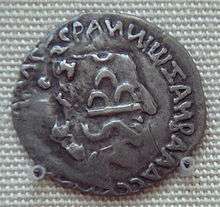
.jpg)
The Satavahana power was revived by Gautamiputra Satakarni, who is considered the greatest of the Satavahana rulers.[48] Charles Higham dates his reign c. 103 – c. 127 CE.[48] S. Nagaraju dates it 106–130 CE,[63] the new consensus is shared by Shailendra Bhandare, Akira Shimada, and Oskar von Hinuber, who regard Gautamiputra Satakarni's reign was ca. 60-85 CE,[64][65][66] Andrew Ollett considers it as 60-84 CE.[67] The king defeated by him appears to have been the Western Kshatrapa ruler Nahapana, as suggested by Nahapana's coins overstuck with names and titles of Gautamiputra.[61] The Nashik prashasti inscription of Gautamiputra's mother Gautami Balashri, dated to the 20th year after his death, records his achievements. The most liberal interpretation of the inscription suggests that his kingdom extended from the present-day Rajasthan in the north to Krishna river in the south, and from Saurashtra in the west to Kalinga in the east. He assumed the titles Raja-Raja (King of Kings) and Maharaja (Great King), and was described as the Lord of Vindhya.[8]
During the last years of his reign, his administration was apparently handled by his mother, which could have been a result of an illness or military preoccupation.[8] According to the Nasik inscription made by his mother Gautami Balashri, he was the one ...[68]
… who crushed down the pride and conceit of the Kshatriyas; who destroyed the Sakas (Western Satraps), Yavanas (Indo-Greeks) and Pahlavas (Indo-Parthians),... who rooted out the Khakharata family (the Kshaharata family of Nahapana); who restored the glory of the Satavahana race.
— Inscription of Queen Mother Gautami Balashri at Cave No.3 of the Pandavleni Caves in Nashik.
Gautamiputra was succeeded by his son Vasisthiputra Sri Pulamavi (or Pulumayi). According to Sailendra Nath Sen, Pulumavi ruled from 96–119 CE.[8] According to Charles Higham, he ascended the throne around 110 CE,[48] according to Shailendra Bhandare, Akira Shimada, and Oskar von Hinuber Vasisthiputra Sri Pulamavi ruled ca. 85-125 CE,[64][69][70] and Andrew Ollett considers it to be ca. 84-119 CE.[67] Pulumavi features in a large number of Satavahana inscriptions and his coins have been found distributed over a wide area. This indicates that he maintained Gautamiputra's territory, and ruled a prosperous kingdom. He is believed to have added the Bellary region to Satakarni's kingdom. His coins featuring ships with double mast have been found on the Coromandel Coast, indicating involvement in maritime trade and naval power. The old stupa at Amaravati was renovated during his reign.[8]
Second Western Satraps invasion under Rudradaman I

Pulumavi's successor was his brother Vashishtiputra Satakarni. According to S. N. Sen he ruled during 120–149 CE;[8] according to Charles Higham, his regnal years spanned 138–145 CE.[48] He entered into a marriage alliance with the Western Satraps, marrying the daughter of Rudradaman I.[8]
The Junagadh inscription of Rudradaman I states that he defeated Satakarni, the lord of Dakshinapatha (Deccan), twice. It also states that he spared the life of the defeated ruler because of close relations:[48]
"Rudradaman (...) who obtained good report because he, in spite of having twice in fair fight completely defeated Satakarni, the lord of Dakshinapatha, on account of the nearness of their connection did not destroy him."
— Junagadh rock inscription
According to D. R. Bhandarkar and Dineshchandra Sircar, the ruler defeated by Rudradaman was Gautamiputra Satakarni. However, E. J. Rapson believed that the defeated ruler was his son Vasishthiputra Pulumavi.[71] Shailendra Nath Sen and Charles Higham believe that the defeated ruler was Vashishtiputra's successor Shivaskanda or Shiva Sri Pulumayi (or Pulumavi).[48][8]
As a result of his victories, Rudradaman regained all the former territories previously held by Nahapana, except for the extreme south territories of Pune and Nasik. Satavahana dominions were limited to their original base in the Deccan and eastern central India around Amaravati.
Second revival
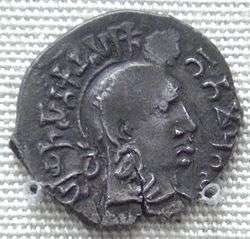
Sri Yajna Sātakarni, the last person belonging to the main Satavahana dynastic line, briefly revived the Satavahana rule. According to S. N. Sen, he ruled during 170–199 CE.[8] Charles Higham dates the end of his reign to 181 CE. His coins feature images of ships, which suggest naval and marine trade success.[48] Wide distribution of his coins, and inscriptions at Nashik, Kanheri and Guntur indicate that his rule extended over both eastern and western parts of Deccan. He recovered much of the territory lost the Western Kshatrapas, and issued silver coinage, imitating them. During the last years of his reign, the Abhiras captured the northern parts of the kingdom, around Nashik region.[8]
Decline
After Yajna Satakarni, the dynasty was soon extinguished following the rise of its feudatories, perhaps on account of a decline in central power.[72] On the other hand, the Western Satraps would continue to prosper for the next two centuries, until their extinction by the Gupta Empire. Yajna Sri was succeeded by Madhariputra Swami Isvarasena. The next king Vijaya ruled for 6 years. His son Vasishthiputra Sri Chadha Satakarni ruled for 10 years.[8] Pulumavi IV, the last king of the main line, ruled until c. 225 CE. During his reign, several Buddhist monuments were constructed at Nagarjunakonda and Amaravati.[48] Madhya Pradesh was also part of his kingdom.[8]
After the death of Pulumavi IV, the Satavahana empire fragmented into five smaller kingdoms:[8]
- Northern part, ruled by a collateral branch of the Satavahanas (which ended in early 4th century[48])
- Western part around Nashik, ruled by the Abhiras
- Eastern part (Krishna-Guntur region), ruled by the Andhra Ikshvakus
- South-western parts (northern Karanataka), ruled by the Chutus of Banavasi
- South-eastern part, ruled by the Pallavas
Territorial extent
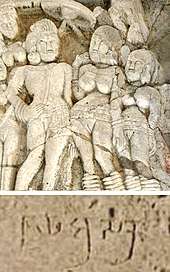
The Satavahana territory included northern Deccan region, spanning the present-day Andhra Pradesh, Maharashtra and Telangana states. At times, their rule also extended to present-day Gujarat, Karnataka and Madhya Pradesh. The Nashik prashasti inscription issued by Gautami Balashri, the mother of Gautamiputra Satakarni, claims that her son ruled an extensive territory that stretched from Gujarat in the north to northern Karnataka in the south. It is not clear if Gautamiputra had effective control over these claimed territories. In any case, historical evidence suggests that his control over these territories did not last long.[76] Moreover, this realm was not continuous: many areas in this region remained under the control of the hunter-gatherers and other tribal communities.[77]
The Satavahana capital kept shifting with time. The Nashik inscription describes Gautamiputra as the lord of Benakataka, suggesting that this was the name of his capital. Ptolemy (2nd century CE) mentioned Pratishthana (modern Paithan) as the capital of Pulumavi.[76] At other times, the Satavahana capitals included Amaravati (Dharanikota) and Junnar.[78] M. K. Dhavalikar theorised that the original Satavahana capital was located at Junnar, but had to be moved to Pratishthana because of Saka-Kushana incursions from the north-west.[79]
Several Satavahana-era inscriptions record grants to religious monasteries. The settlements most frequently mentioned as the residences of donors in these inscriptions include the sea ports of Sopara, Kalyan, Bharucha, Kuda (unidentified), and Chaul. The most frequently mentioned inland settlements include Dhenukakata (unidentified), Junnar, Nashik, Paithan, and Karadh.[76]
Other important Satavahana sites in western Deccan include Govardhana, Nevasa, Ter, and Vadgaon-Madhavpur. The ones in eastern Deccan include Amaravati, Dhulikatta, Kotalingala and Peddabankur.[80]
Administration
The Satavahanas followed the administration guidelines of the Shastras. Their government was less top-heavy than that of the Mauryans, and featured several levels of feudatories:[8]
- Rajan, the hereditary rulers
- Rajas, petty princes who struck coins in their own names
- Maharathis, hereditary lords who could grant villages in their own names and maintained matrimonial relations with the ruling family
- Mahabhojas
- Mahasenapati (civil administrator under Pulumavi II; governor of a janapada under Pulumavi IV)
- Mahatalavara ("great watchman")
The royal princes (kumaras) were appointed as viceroys of the provinces.[8]
The ahara appears to have been the largest geographical subdivision of the Satavahana polity. Several inscriptions refer to aharas named after the governors appointed to rule them (e.g. Govardhanahara, Mamalahara, Satavanihara and Kapurahara).[76] This suggests that the Satavahanas attempted to build a formal administrative and revenue collection structure.[81]
The inscriptions of Gautamiputra Satakarni suggest the existence of a bureaucratic structure, although it is not certain how stable and effective this structure was. For example, two inscriptions from Nashik Cave 11 record donations of agricultural land to ascetic communities. They state that the ascetics would enjoy tax exemption and non-interference from the royal officials. The first inscription states that the grant was approved by Gautamiputra's minister Sivagupta on the king's verbal orders, and preserved by the "great lords". The second inscription records a grant by Gautamiputra and his mother, and mentions Syamaka as the minister of the Govardhana ahara. It states that the charter was approved by a woman named Lota, who according to archaeologist James Burgess' interpretation, was the chief lady-in-waiting of Gautamiputra's mother.[82]
The Satavahana-era inscriptions mention three types of settlements: nagara (city), nigama (market town) and gama (village).[76]
According to Sastri, "the Satavahanas were described as 'lords of the three oceans' and promoted overseas colonization and trade. Under them, Buddhist art attained the superb forms of beauty and elegance preserved to this day in the cave-temples of western India and the survivals from the stupa of Amaravati, Goli, Nagarjunikonda".[83] This tradition was followed by successors of Satavahana in the eastern and western Deccan.[83]
Economy

The Satavahanas participated in (and benefited from) economic expansion through intensification of agriculture, increased production of other commodities, and trade within and beyond the Indian subcontinent.[84]
During the Satavahana period, several large settlements emerged in the fertile areas, especially along the major rivers. The amount of land under agricultural use also expanded significantly, as a result of forest clearance and construction of irrigation reservoirs.[81]
The exploitation of sites with mineral resources may have increased during the Satavahana period, leading to the emergence of new settlements in these areas. Such sites facilitated commerce and crafts (such as ceramic ware). The increased craft production during the Satavahana period is evident from archaeological discoveries at sites such as Kotalingala, as well as epigraphic references to artisans and guilds.[81]
The Satavahanas controlled the Indian sea coast, and as a result, they dominated the growing Indian trade with the Roman Empire. The Periplus of the Erythraean Sea mentions two important Satavahana trade centres: Pratishthana and Tagara. Other important urban centres included Kondapur, Banavasi and Madhavpur. Nanaghat was the site of an important pass that linked the Satavahana capital Pratishthana to the sea.[48]
Religion
The Satavahanas were Hindus and claimed Brahmanical status,[85] although they also made generous donations to Buddhist monasteries.[86] The lay people in the Satavahana period generally did not exclusively support a particular religious group .[60]
The Naneghat inscription of Nayanika, recorded on the walls of a Buddhist monastic cave, mentions that her husband Satakarni I performed several Vedic sacrifices, including ashvamedha (horse sacrifice), rajasuya (royal consecration), and agnyadheya (fire ceremony).[87] The inscription also records subsantial fees paid to Brahmin priests and attendees for these sacrifices. For example, 10,001 cows were granted for the Bhagala-Dasaratra sacrifice; and 24,400 coins were granted for another sacrifice, whose name is not clear.[88]
In the Nashik inscription of Gautami Balashri, her son Gautamiputra Satakarni is called "ekabamhana", which is interpreted by some as "unrivaled Brahmana", thus indicating a Brahmin origin. However, R. G. Bhandarkar interprets this word as "the only protector of the Brahmins".[89]
A number of Buddhist monastic sites emerged in the Deccan region during the Satavahana period. However, the exact relations between these monasteries and the Satavahana government is not clear.[80] The Pandavleni Caves inscription issued during the reign of Kanha states that the cave was excavated by maha-matra (officer-in-charge) of the shramanas (non-Vedic ascetics). Based on this, Sudhakar Chattopadhyaya concludes that Kanha favoured Buddhism, and had an administrative department dedicated to the welfare of Buddhist monks.[34]
However, Carla M. Sinopoli notes that although there are some records of donations to the Buddhist monasteries by the Satavahana royals, the vast majority of the donations were made by the non-royals. The most common among these donors were merchants, and many of the monasteries were located along the important trade routes.[80] The merchants probably donated to the monasteries, because these sites facilitated trade by serving as rest houses, and possibly by directly participating in the trade.[85] The monasteries appear to have been an important venue for displaying charitable donations, including the donations made to non-Buddhists (especially Brahmins).[86]
Language
Most of the Satavahana inscriptions and coin legends are in a Middle Indo-Aryan language.[90] This language has been termed "Prakrit" by some modern scholars, but this terminology can be considered correct only if the term "Prakrit" is defined broadly to include every Middle Indo-Aryan language that is "not exactly Sanskrit". The language of the inscriptions is actually closer to Sanskrit than to the literary Prakrit used in the Gaha Sattasai anthology attributed to the Satavahana king Hala.[91]
The Satvahanas also used Sanskrit in political inscriptions, but rarely.[92] A fragmentary inscription found close to the Nashik prashasti of Gautamiputra Satakarni uses Sanskrit verses in vasanta-tilaka metre to describe a deceased king (probably Gautamiputra). A Sanskrit inscription found at Sannati probably refers to Gautamiputra Shri Satakarni, one of whose coins also features a Sanskrit legend.[90]
The Satavahanas also issued bilingual coins featuring Middle Indo-Aryan language on one side, and Tamil language on the other side.[93]
Inscriptions
.jpg)
Several Brahmi script inscriptions are available from the Satavahana period, but most of these record donations to Buddhist institutions by individuals, and do not provide much information about the dynasty. The inscriptions issued by the Satavahana royals themselves also primarily concern religious donations, although some of them provide some information about the rulers and the imperial structure.[94]
The earliest extant Satavahana inscription is from Nashik Cave 19, which states that the cave was commissioned by Mahamatra Saman of Nashik during the reign of king Kanha.[4]
At Naneghat, an inscription issued by Nayanika, the widow of Satakarni I, has been found. It records Nayanika's lineage and mentions the Vedic sacrifices performed by the royal family.[4] Another inscription at Naneghat comprises names of Satavahana royals, appearing as labels over their bas-relief portraits. The portraits are now completely eroded, but the inscription is believed to be contemporary to Nayanika's inscription on a paleographic basis.[23]
The next oldest Satavahana-era inscription appears on a sculpted gateway element of Stupa 1 at Sanchi. It states that the element was donated by Ananda, who was the son of Siri Satakarni's foreman of artisans. This inscription is probably from the reign of Satakarni II.[23]
Coinage
Obverse: Portrait of the king. Legend in Prakrit in the Brahmi script (starting at 12 o'clock):
𑀭𑀜𑁄 𑀯𑀸𑀲𑀺𑀣𑀺𑀧𑀼𑀢𑀲 𑀲𑀺𑀭𑀺 𑀧𑀼𑀎𑀼𑀫𑀸𑀯𑀺𑀲
Raño Vāsiṭhiputasa Siri-Puḷumāvisa
"Of King Lord Pulumavi, son of Vasishthi"
Reverse: Ujjain and arched-hill symbols. Legend in Dravidian (close to Telugu and Tamil),[95] and the Dravidian script,[95] essentially similar to the Brahmi script[96] (starting at 12 o'clock):
𑀅𑀭𑀳𑀡𑀓𑀼 𑀯𑀸𑀳𑀺𑀣𑀺 𑀫𑀸𑀓𑀡𑀓𑀼 𑀢𑀺𑀭𑀼 𑀧𑀼𑀮𑀼𑀫𑀸𑀯𑀺𑀓𑀼
Arahaṇaku Vāhitti Mākaṇaku Tiru Pulumāviku[97]
or: Aracanaku Vācitti Makaṇaku Tiru Pulumāviku[98]
"Of King Tiru Pulumavi, son of Vasishthi"[96]
The Satavahanas were the earliest Indian rulers to issue their own coins with portraits of their rulers, starting with king Gautamiputra Satakarni, a practice derived from that of the Western Kshatrapas he defeated.[99] The Western Satraps themselves had been following the features of the coins of the Indo-Greek kings to the northwest.[100]
Thousands of lead, copper and potin Satavahana coins have been discovered in the Deccan region; a few gold and silver coins are also available. These coins do not feature uniform design or size, and suggest that multiple minting locations existed within the Satavahana territory, leading to regional differences in coinage.[94]
The coin legends of the Satavahanas, in all areas and all periods, used a Prakrit dialect without exception. In addition, some reverse coin legends are in Dravidian[95] (similar to the Tamil[101][102] and Telugu languages),[95][94] in the Dravidian script (similar to the Brahmi script apart from a few variations).[95][96]
Several coins carry titles or matronyms that were common to multiple rulers (e.g. Satavahana, Satakarni, and Pulumavi), so the number of rulers attested by coinage cannot be determined with certainty. The names of 16 to 20 rulers appear on the various coins. Some of these rulers appear to be local elites rather than the Satavahana monarchs.[94]
The Satavahana coins give unique indications as to their chronology, language, and even facial features (curly hair, long ears and strong lips). They issued mainly lead and copper coins; their portrait-style silver coins were usually struck over coins of the Western Kshatrapa kings. The Satavahana coins also display various traditional symbols, such as elephants, lions, horses and chaityas (stupas), as well as the "Ujjain symbol", a cross with four circles at the end.
Other examples

Nisa.jpg) Satavahana 1st century BCE coin inscribed in Brahmi: "(Sataka)Nisa". British Museum
Satavahana 1st century BCE coin inscribed in Brahmi: "(Sataka)Nisa". British Museum Coin of Gautamiputra Yajna Satakarni (r. 167 – 196 CE).
Coin of Gautamiputra Yajna Satakarni (r. 167 – 196 CE).
Cultural achievements
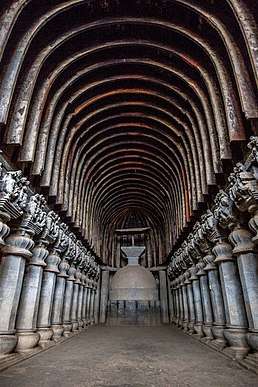
The Satavahanas patronised the Prakrit language instead of Sanskrit.[8] The Satavahana king Hāla is famous for compiling the collection of Maharashtri poems known as the Gaha Sattasai (Sanskrit: Gāthā Saptashatī), although from linguistic evidence it seems that the work now extant must have been re-edited in the succeeding century or two. Through this book, it was evident that agriculture was the main means of livelihood. Also many sorts of superstitions had prevailed. Additionally, Gunadhya, the minister of Hala, was the author of Brihatkatha.[103]
Sculptures
Madhukar Keshav Dhavalikar writes that "The Satavahana sculptures unfortunately has never been recognized as an independent school in spite of the fact it has its own distinctive characteristic features. The earliest in point of time is that in the Bhaja Vihara cave which marks the beginning of sculptural art in the Satavahana dominion around 200BC. It is profusely decorated with carvings, and even pillars have a lotus capital crowned with sphinx-like mythic animals."[104] Dhavalikar also writes that in Chankama "the panel occurring on the west pillar of Northern Gateway portrays a very important event in Buddha's life. It depicts votaries, two each on either side of what looks like a ladder which actually is the promenade which Buddha is supposed to have walked. It is said that Buddha, after attaining Enlightment, spent four weeks near the Bodhi tree. Of these, the third week he spent walking along the promenade (chankama) to and fro."[105]
Along with some of the above major Satavahana sculptures some more sculptures existed—namely, Dvarapala, Gajalaksmi, Shalabhanjikas, Royal Procession, Decorative pillar, etc.[106]
Bronze

Several metal figurines are found that could be attributed to the Satavahanas. A hoard of unique bronze objects were also found from Bramhapuri. Numerous articles obtained from there were Indian but also reflected Roman and Italian influence. A small statue of Poseidon, wine jugs, and a plaque depicting Perseus and Andromeda were also obtained from the house from where the objects were found.[107] The fine elephant in the Ashmolean Museum, the Yaksi image in the British Museum,[108] and the cornucopia found in Posheri, kept at Chhatrapati Shivaji Maharaj Vastu Sangrahalaya[109] can also be attributed to the Satavahana period.
Architecture
The sculptures of the Amaravati Stupa represent the architectural development of the Satavahana periods. They built Buddhist stupas in Amravati (95 feet high). They also constructed a large number of stupas at Goli, Jaggiahpeta, Gantasala, Amravati Bhattiprolu, and Shri Parvatam. Caves IX and X, containing Ajanta paintings, were patronised by Satavahana, and the painting throughout the caves appear to have started with them. Ashokan Stupas were enlarged, the earlier bricks and wood works being replaced with stone works. The most famous of these monuments are the stupas, the most famous among them being the Amravati Stupa and the Nagarjunakonda Stupa.
Paintings
The Satavahana paintings are the earliest surviving specimens—excluding prehistoric rock art—in India, and they are to be found only at the Ajanta Caves. There were two phases of artistic activity of Ajanta: the first occurring in the 2nd to 1st centuries BC, when Hinayana caves were excavated during Satavahana rule; the later in the second half of the 5th century under the Vakatakas. Vagaries of nature and some vandalism have taken a heavy toll on the Ajanta Caves. Only a few fragments related to the Satavahanas have survived in Caves No. 9 and 10, both of which are chaitya-grihas with stupas.
The most important surviving painting of the Satavahana period at Ajanta is the Chhadanta Jataka in Cave No. 10, but that, too, is only fragmentary. It is a painting of an elephant named Bodhisattva with six tusks, related to a mythological story. The human figures, both male and female, are typically Satavahanas, almost identical with their counterparts on the Sanchi Gateways so far as their physiognomy, costumes, and jewellery are concerned. The only difference is that the Sanchi figures have shed some of their weight.[110]
Art of Amaravati
The Satavahana rulers are also remarkable for their contributions to Buddhist art and architecture. They built great stupas in the Krishna River Valley, including the stupa at Amaravati in Andhra Pradesh. The stupas were decorated in marble slabs and sculpted with scenes from the life of the Buddha, portrayed in a characteristic slim and elegant style. The Amaravati style of sculpture also influenced the sculpture of Southeast Asia.[111]
 Amaravati Marbles, fragments of Buddhist stupa
Amaravati Marbles, fragments of Buddhist stupa- Fragment of Amaravati stupa
 Mara's assault on the Buddha, 2nd century, Amaravati
Mara's assault on the Buddha, 2nd century, Amaravati.jpg) Ajanta Cave No. 9, possibly of Satavahana era
Ajanta Cave No. 9, possibly of Satavahana era- Scroll supported by Indian Yaksha, Amaravati, 2nd–3rd century CE.
List of rulers
Multiple Puranas contain chronology of Satavahana kings. However, there are inconsistencies among the various Puranas over the number of kings in the dynasty, the names of the kings, and the length of their rule. In addition, some of the kings listed in the Puranas are not attested via archaeological and numismatic evidence. Similarly, there are some kings known from coins and inscriptions, whose names are not found in the Puranic lists.[43][45]
The reconstructions of the Satavahana kings by historians fall into two categories. According to the first one, 30 Satavahana kings ruled for around 450 years, starting from Simuka's rule immediately after the fall of the Mauryan empire. This view relies heavily on the Puranas, and is now largely discredited. According to the second (and more widely accepted) category of reconstructions, the Satavahana rule started in around first century BCE. The chronologies in this category contain a smaller number of kings, and combine Puranic records with archaeological, numismatic and textual evidence.[112]
Because of uncertainty regarding the establishment date of the Satavahana kingdom, it is difficult to give absolute dates for the reigns of the Satavahana kings.[43] Therefore, many modern scholars do not assign absolute dates to the reigns of the historically attested Satavahana kings, and those who do vary greatly with each other.[10]
Himanshu Prabha Ray provides the following chronology, based on archaeological and numismatic evidence:[17]
- Simuka (before 100 BCE)
- Kanha (100–70 BCE)
- Satakarni I (70–60 BCE)
- Satakarni II (50–25 BCE)
- Kshatrapa interregnum with vassal Satavahana kings like Hāla
- Nahapana (54-100 CE)
- Gautamiputra Satakarni (86–110 CE)
- Pulumavi (110–138 CE)
- Vashishtiputra Satakarni (138–145 CE)
- Shiva Shri Pulumavi (145–152 CE)
- Shiva Skanda Satakarni (145–152 CE)
- Yajna Shri Satakarni (152–181 CE)
- Vijaya Satakarni
- Regional rulers of south-eastern Deccan:[84]
- Chandra Shri
- Pulumavi II
- Abhira Isvarasena
- Madhariputra Sakasena
- Haritiputra Satakarni
Puranic lists
The various Puranas give different lists of the Satavahana rulers. The Matsya Purana states that 30 Andhra kings ruled for 460 years, but some of its manuscripts name only 19 kings whose reigns add up to 448.5 years. The Vayu Purana also mentions that there were 30 Andhra kings, but its various manuscripts name only 17, 18, and 19 kings respectively; the reigns add up to 272.5, 300, and 411 years respectively. Many of these kings are not attested by historical evidence. On the other hand, some Satavahana kings attested by numismatic evidence (such as Rudra Satakarni) are not mentioned in the Puranas at all.[113]
Different scholars have explained these anomalies in different ways. Scholars such as R. G. Bhandarkar, D. C. Sircar and H. C. Raychaudhuri theorised that the Vayu Purana mentions only the main imperial branch of the dynasty, while the Matsya Purana puts together princes of all its branches.[113]
The names of the Andhra kings (in IAST), as mentioned in the various Puranas, are given below. These names vary across different manuscripts of the same Puranas, and some names are missing in some of the manuscripts. The list given below for each Purana contains the most exhaustive version. In the Puranas, Krishna (IAST: Kṛṣṇa) is described as brother of the first king, who overthrew the Kanva king Susharman. All other kings are described as sons of their predecessors. The first king of the Andhra-Bhrityas is also known as Shudraka or Suraka in the Kumarika Khanda of Skanda Purana (not present in the table below).[114]
| # | Ruler | Coins | Epigraphy | Bhagavata | Brahmanda | Matsya | Vayu | Vishnu | Reign (years) | Alternative names and reigns[116][117] |
|---|---|---|---|---|---|---|---|---|---|---|
| 1 | Simuka | ✓ | ✓ | ✓ | ✓ | ✓ | ✓ | ✓ | 23 | Śiśuka (Matsya), Sindhuka (Vayu), Śipraka (Vishnu), Chhismaka (Brahmanda) |
| 2 | Kṛṣṇa (Kanha) | ✓ | ✓ | ✓ | ✓ | ✓ | ✓ | ✓ | 18 | |
| 3 | Śatakarṇi I | ✓ | ✓ | ✓ | ✓ | ✓ | ✓ | ✓ | 10 | Śantakarṇa (Bhagavata), Mallakarni - 10 or 18 years (Matsya), Śri Śatakarṇi (Vishnu) |
| 4 | Pūrṇotsanga | ✓ | ✓ | ✓ | ✓ | 18 | Paurṇamāsa (Bhagavata) | |||
| 5 | Skandastambhi | ✓ | ✓ | 18 | Śrivasvani (Matsya) | |||||
| 6 | Śatakarṇi II | ✓ | ✓ | ✓ | ✓ | ✓ | ✓ | ✓ | 56 | |
| 7 | Lambodara | ✓ | ✓ | ✓ | ✓ | 18 | ||||
| 8 | Āpīlaka | ✓ | ✓ | ✓ | ✓ | ✓ | ✓ | 12 | Apītaka (Matsya), Ivīlaka (Vishnu), Hivilaka (Bhagavata) | |
| 9 | Meghasvāti | ✓ | ✓ | ✓ | ✓ | ✓ | 18 | Saudāsa (Brahmanda) | ||
| 10 | Svāti (Śatakarṇi) | ✓ | ✓ | ✓ | ✓ | 12 | ||||
| 11 | Skandasvāti | ✓ | ✓ | 7 | Skandasvati - 28 years (Brahmanda) | |||||
| 12 | Mṛgendra-Svātikarṇa | ✓ | ✓ | 3 | Mahendra Śatakarṇi (Brahmanda) | |||||
| 13 | Kuntala-Svātikarṇa | ✓ | ✓ | 8 | ||||||
| 14 | Svātikarṇa | ✓ | ✓ | 1 | ||||||
| 15 | Pulomavi I | ✓ | ✓ | ✓ | ✓ | ✓ | 24 | Pulomavi - 36 years (Matsya), Aṭamāna (Bhagavata), Paṭimavi (Vayu), Paṭumat (Vishnu), Ābhi - Brahmanda | ||
| 16 | Gaurakṛṣṇa | ✓ | ✓ | ✓ | ✓ | 25 | Gorakśāśvaśri (Matsya), Nemi Kṛṣṇa (Vayu), Arishṭakarman (Vishnu) | |||
| 17 | Hāla | ✓ | ✓ | ✓ | ✓ | 5 | Hāleya (Bhagavata); 1 year in one manuscript | |||
| 18 | Mandalaka | ✓ | ✓ | ✓ | ✓ | ✓ | 5 | Talaka (Bhagavata), Saptaka (Vayu), Pattalaka (Vishnu), Bhavaka (Brahmanda) | ||
| 19 | Purindrasena | ✓ | ✓ | ✓ | ✓ | ✓ | 5 | Purīṣabhiru (Bhagavata), Purikaṣena - 21 years (Vayu), Pravillasena (Vishnu), Pravillasena - 12 years (Brahmanda) | ||
| 20 | Sundara Śatakarṇi | ✓ | ✓ | ✓ | ✓ | ✓ | 1 | Sundara Svatikarṇa (Matsya), Sunandana (Bhagavata) | ||
| 21 | Cakora Śatakarṇi (Chakora) | ✓ | ✓ | ✓ | ✓ | ✓ | 0.5 | |||
| 22 | Śivasvāti | ✓ | ✓ | ✓ | ✓ | ✓ | 28 | Svātisena - 1 year (Brahmanda), Śivasvāmi (Vayu) | ||
| 23 | Gautamīputra | ✓ | ✓ | ✓ | ✓ | ✓ | ✓ | ✓ | 21 | Yantramati - 34 years (Brahmanda), Gotamīputra (Bhagavata and Vishnu); 24 years according to inscriptions |
| 24 | Pulomavi II (Vashishtiputra) | ✓ | ✓ | ✓ | ✓ | ✓ | 28 | Purīmān (Bhagavata), Pulomat (Matsya), Pulimat (Vishnu). See also: Vashishtiputra Satakarni. | ||
| 25 | Śivaśri | ✓ | ✓ | ✓ | ✓ | ✓ | ✓ | 7 | Madaśirā (Bhagavata) | |
| 26 | Śivaskanda Śatakarṇi | ✓ | ✓ | ✓ | ✓ | ✓ | ✓ | 7 | ||
| 27 | Yajñaśri | ✓ | ✓ | ✓ | ✓ | ✓ | ✓ | ✓ | 29 | Yajñaśri Śatakarṇi - 19 years (Brahmanda), Yajñaśri - 9, 20 or 29 years (Matsya) |
| 28 | Vijaya | ✓ | ✓ | ✓ | ✓ | ✓ | ✓ | 6 | ||
| 29 | Candraśri (Chandrashri) | ✓ | ✓ | ✓ | ✓ | ✓ | ✓ | ✓ | 3 | Candravijaya (Bhagavata), Daṇḍaśri (Brahmanda and Vayu), Vada-Śri or Candra-Śri-Śatakarṇi - 10 years (Matsya) |
| 30 | Pulomavi III | ✓ | ✓ | ✓ | ✓ | ✓ | ✓ | ✓ | 7 | Sulomadhi (Bhagavata), Pulomavit (Matsya), Pulomarchis (Vishnu) |
Purana-based lists
S. Nagaraju relies on the Puranic lists of 30 kings, and gives the following regnal dates:[63]
- Simuka (r. 228 – 205 BCE)
- Krishna (r. 205 – 187 BCE)
- Satakarni I (r. 187 – 177 BCE)
- Purnotsanga (r. 177 – 159 BCE)
- Skandhastambhi (r. 159 – 141 BCE)
- Satakarni II (r. 141 – 85 BCE)
- Lambodara (r. 85 – 67 BCE)
- Apilaka (r. 67 – 55 BCE)
- Meghasvati (r. 55 – 37 BCE)
- Svati (r. 37 – 19 BCE)
- Skandasvati (r. 19 – 12 BCE)
- Mrigendra Satakarni (r. 12 – 9 BCE)
- Kunatala Satakarni (r. 9 – 1 BCE)
- Satakarni III (r. 1 BCE-1 CE)
- Pulumavi I (r. 1 – 36 CE)
- Gaura Krishna (r. 36 – 61 CE)
- Hāla (r. 61 – 66 CE)
- Mandalaka aka Puttalaka or Pulumavi II (r. 69 – 71 CE)
- Purindrasena (r. 71 – 76 CE)
- Sundara Satakarni (r. 76 – 77 CE)
- Chakora Satakarni (r. 77 – 78 CE)
- Shivasvati (r. 78 – 106 CE)
- Gautamiputra Satkarni (r. 106 – 130 CE)
- Vasisthiputra aka Pulumavi III (r. 130 – 158 CE)
- Shiva Sri Satakarni (r. 158 – 165 CE)
- Shivaskanda Satakarni (r. 165–172)
- Sri Yajna Satakarni (r. 172 – 201 CE)
- Vijaya Satakarni (r. 201 – 207 CE)
- Chandra Sri Satakarni (r. 207 – 214 CE)
- Pulumavi IV (r. 217 – 224 CE)
Towards a Mid-Chronology
Apart from the two traditional views (long and short chronologies) there is another kind of analysis pointing out to a "Mid-Chronology", as it was already proposed by Dr. Dehejia and others, and particularly most recently by Shailendra Bhandare, who regards Satavahana's rule extended more than three centuries (c. 150 BCE to 250 CE)[118] with the flourish of trans-national trade, urbanism and monumental architecture in South India.
Bhandare regards Simuka to have ruled since around 160-150 BCE and that this date would still fit in well with Pargiter's 460 years to the Satavahanas, as it would fix the end of the dynasty around 300 CE, not too far from the mid-3rd century as consensus approximately lies.[119] Regarding Siri Satakani and his wife Naganika, Bhandhare considers their rule to have been somewhere around 110 +/- 20 BCE.[119]
Bhandare also suggests the following sequence of reigns, based on his analysis of Satavahana coinage:[120]
- Gautamiputa Satakani (ca. 60-85 CE)
- Vasithiputa Siri Pulumayi (ca. 85-125 CE)
- Vasithiputa Siri Satakani (ca. 125-152 CE)
- Vasithiputa Siva Siri Pulumayi (ca. 152-160 CE)
- Vasithiputa Siri Khada Satakani (ca. 160-165 CE)
- Vasithiputa Vijaya Satakani (ca. 165-170 CE)
- Siri Yaña Satakani (ca. 170-200 CE)
- Gotamiputa Siri Cada (ca. 200-215 CE)
- Gotamiputa Siri Vijaya Satakani (ca. 215-225 CE)
On the other hand, based to a large degree on Shailendra Bhandare's work, with slight corrections, Andrew Ollett (2017) mentions the following reigns for the whole Satavahana dynasty:[121]
- Vasisthiputra Sri Chimuka Satavahana (ca. 120-96 BCE)
- Krsna (ca. 96-88 BCE)
- Sri Satakarni (ca. 88-42 BCE)
- Sakti
- Mantalaka
- Sundara
- Gautamiputra Siva Satakarni (?-60 CE)
- Gautamiputra Sri Satakarni (ca. 60-84 CE)
- Vasisthiputra Sri Pulumavi (ca. 84-119 CE)
- Vasisthiputra Sri Satakarni (ca. 119-148 CE)
- Vasisthiputra Sivasri Pulumavi (ca. 148-156 CE)
- Vasisthiputra Sriskanda Satakarni (ca. 156-170 CE)
- Gautamiputra Sriyajña Satakarni (ca. 171-199 CE)
- Gautamiputra Srivijaya Satakarni (ca. 200-205 CE)
- Vasisthiputra Sricanda Satakarni (ca. 206-220 CE)
- Mathariputra Sri Pulumavi (ca. 220-230 CE)
References
Citations
- K.M., Dayashankar (26 September 2014). "Koti Lingala, a major pilgrim destination". The Hindu. Retrieved 25 February 2020.
- Burgess. Epigraphia Indica Vol 8. p. 93.
- Alcock, Susan E.; Alcock, John H. D'Arms Collegiate Professor of Classical Archaeology and Classics and Arthur F. Thurnau Professor Susan E.; D'Altroy, Terence N.; Morrison, Kathleen D.; Sinopoli, Carla M. (2001). Empires: Perspectives from Archaeology and History. Cambridge University Press. p. 166. ISBN 9780521770200.
- Carla M. Sinopoli 2001, p. 168.
- "CNG: eAuction 417. INDIA, Post-Mauryan (Deccan). Satavahanas (Andhras). Śri Satakarṇi. Circa 70-60 BC. BI Karshapana (19mm, 3.44 g)". www.cngcoins.com. Retrieved 11 December 2019.
- Ajay Mitra Shastri 1998, pp. 20-21.
- I. K. Sarma 1980, p. 3.
- Sailendra Nath Sen 1999, pp. 172–176.
- Damodar Dharmanand Kosambi 1975, p. 243.
- Carla M. Sinopoli 2001, p. 166.
- Zvelebil, Kamil (1992). Companion Studies to the History of Tamil Literature. p. 118.
- Zvelebil, Kamil (1975). Tamil literature. p. 42.
- "The Journal of the Numismatic Society of India". Numismatic Society of India. 53. 1991.
- "Pauni : (Vidarbha) The latest site which contributed valuable numismatic evidence confirming, once and for all, ancient Vidarbha's early Satavahana affiliation is Pauni, in district Bhandara. Two seasons of joint excavation (1968-70) by the Nagpur University and the Archaeological Survey of India yielded reliable coin data from both the Stupa sites." in Sarma, Inguva Karthikeya (1980). Coinage of the Satavahana Empire. Agam. p. 38.
- "Coins of a number of Satavahana rulers from Gautamiputra Satakarni onward have been discovered in large numbers in the Vidarbha region. However, no coin of any earlier king has been reported so far. The present coin is, therefore, the first coin of Sri-Satakarni to be reported from Vidarbha. Another potin coin of Sri-Satakarni has been recently discovered at Pauni 2. The discovery of these coins indicates for the first time the possibility of the rule of the early Satavahanas over the Vidarbha region." Deo, Shantaram Bhalchandra; Joshi, Jagat Pati (1972). Pauni Excavation, 1969-70. Nagpur University. p. 99.
- "The bas-relief at Pauni or Bharhut in India, which dates back to about the second century B.C., represents a vacant throne protected by a naga with many heads. It also bears an inscription of the Naga Mucalinda (Fig. 3)" SPAFA Digest: Journal Of SEAMEO Project in Archaeology and Fine Arts (SPAFA). SPAFA Co-ordinating Unit. 1987. p. 4.
- Carla M. Sinopoli 2001, p. 167.
- Staff, Rao P. R.; Rao, P. Raghunadha (1989). Indian Heritage and Culture. Sterling Publishers Pvt. Ltd. p. 24. ISBN 9788120709300.
- Himanshu Prabha Ray 1986, p. 43.
- Ajay Mitra Shastri 1999, p. 306.
- P. Raghunadha Rao 1993, p. 5.
- SHASTRI, AJAY MITRA. "SĀTAVĀHANAS: ORIGINAL HOME AND NOMENCLATURE.” Bulletin of the Deccan College Research Institute, 54/55, 1994, p. 381
- Carla M. Sinopoli 2001, p. 169.
- I. K. Sarma 1980, pp. 126-130.
- Akira Shimada 2012, p. 45.
- Rocher, Ludo (1986). The Purāṇas. Otto Harrassowitz Verlag. p. 249. ISBN 9783447025225.
- Brancaccio, Pia (2010). The Buddhist Caves at Aurangabad: Transformations in Art and Religion. BRILL. p. 61. ISBN 978-9004185258.
- Ollett, Andrew, (2017). Language of the Snakes: Prakrit, Sanskrit, and the Language Order of Premodern India, University of California Press, Okland, p. 194.
- Poonacha, K.P., (2013). Excavations at Kanaganahalli, Archaeological Survey of India, Delhi
- Nakanishi, Maiko, and Oskar von Hinuber, (2014). Kanaganahalli Inscriptions (Supplement to the Annual Report of the International Research Institute for Advanced Buddhology at Soka University for the Academic Year 2013, Vol. 17., Tokyo.
- B. S. L. Hanumantha Rao 1976, p. 8.
- Singh 2008, pp. 381–382.
- Carla M. Sinopoli 2001, p. 168-170.
- Sudhakar Chattopadhyaya 1974, pp. 17-56.
- Carla M. Sinopoli 2001, pp. 167-168.
- Sailendra Nath Sen 1999, p. 172.
- Hemchandra Raychaudhuri 2006, pp. 342, 360, 363–364.
- Ranade, P. V. "THE ORIGIN OF THE SATAVAHANAS—A NEW INTERPRETATION." Proceedings of the Indian History Congress, vol. 26, 1964, p. 62
- Akira Shimada 2012, p. 43.
- Carla M. Sinopoli 2001, pp. 162-163.
- M. K. Dhavalikar 1996, p. 133.
- Ajay Mitra Shastri 1998, p. 42.
- Upinder Singh 2008, pp. 381–384.
- Thapar 2013, p. 296.
- Sudhakar Chattopadhyaya 1974, pp. 17–56.
- Alcock, Susan E.; Alcock, John H. D'Arms Collegiate Professor of Classical Archaeology and Classics and Arthur F. Thurnau Professor Susan E.; D'Altroy, Terence N.; Morrison, Kathleen D.; Sinopoli, Carla M. (2001). Empires: Perspectives from Archaeology and History. Cambridge University Press. p. 169. ISBN 9780521770200.
- John Marshall, "A guide to Sanchi", p.48
- Charles Higham 2009, p. 299.
- Upinder Singh 2008, p. 382.
- Sailendra Nath Sen 1999, pp. 176–177.
- Bhagwanlal Indraji (1885). "The Hâtigumphâ and three other inscriptions in the Udayagiri caves near Cuttack". Proceedings of the Leyden International Oriental Congress for 1883. pp. 144–180.
- Sudhakar Chattopadhyaya 1974, pp. 44–50.
- Alain Daniélou (11 February 2003). A Brief History of India. Inner Traditions / Bear & Co. pp. 139–141. ISBN 978-1-59477-794-3.
- Indian History. Tata McGraw-Hill Education. p. 251. ISBN 9781259063237.
- Jain, Kailash Chand (1972). Malwa Through The Ages. Motilal Banarsidass Publ. p. 154. ISBN 9788120808249.
- Ollett, Andrew, (2017). Language of the Snakes: Prakrit, Sanskrit, and the Language Order of Premodern India, University of California Press, Okland, footnote 5, p. 190 and p. 195.
- Falk, Harry, (2009). "Two Dated Satavahana Epigraphs", in Indo-Iranian Journal 52, pp. 197-200.
- Satavahana Art by M.K. Dhavalikar, p.19
- Original text "L1: Rano Siri Satakarnisa L2: avesanisa Vasithiputasa L3: Anamdasa danam", Marshall, John. A guide to Sanchi. p. 52.
- R.C.C. Fynes 1995, p. 43.
- R.C.C. Fynes 1995, p. 44.
- Hultzsch, E. (1906). Epigraphia Indica Vol.8. p. 60.
- Rajesh Kumar Singh (2013). Ajanta Paintings: 86 Panels of Jatakas and Other Themes. Hari Sena. pp. 15–16. ISBN 9788192510750.
- Bhandare, Shailendra, (1999). Historical Analysis of the Satavahana Era: A study of Coins, University of Mumbai, pp. 168-178.
- Shimada, Akira, (2012). Early Buddhist Architecture in Context: The Great Stupa at Amaravati (ca 300 BCE - 300 CE), Brill, p. 51.
- von Hinuber, Oskar, (2016). "Buddhist Texts and Buddhist Images: New Evidence from Kanaganahalli (Karnataka/India)", ARIRIAB Vol. XIX (March 2016), p. 16.
- Ollett, Andrew, (2017). Language of the Snakes: Prakrit, Sanskrit, and the Language Order of Premodern India, University of California Press, Okland, (Table 2, Appendix A), p. 189.
- Inscription of Queen Mother Gautami Balashri at Cave No.3 of the Pandavleni Caves in Nashik
- Shimada, Akira, (2012). Early Buddhist Architecture in Context: The Great Stupa at Amaravati (ca 300 BCE - 300 CE), Brill, p. 52.
- von Hinuber, Oskar, (2016). "Buddhist Texts and Buddhist Images: New Evidence from Kanaganahalli (Karnataka/India)", ARIRIAB Vol. XIX (March 2016), p. 15.
- Mala Dutta 1990, pp. 52.
- ""The different branches of the Satavahana family, which ruled in different parts of the kingdom after the decline in central authority, were soon ousted by new powers some of which were probably feudatories at the outset." Majumdar, Ramesh Chandra (2003). Ancient India. Delhi: Motilal Banarsidass.
- Thapar, Romila (2012). Aśoka and the Decline of the Mauryas. Oxford University Press. p. 27. ISBN 9780199088683.
- Singh, Upinder (2008). A History of Ancient and Early Medieval India: From the Stone Age to the 12th Century. Pearson Education India. p. 333. ISBN 9788131711200.
- Alcock, Susan E.; Alcock, John H. D'Arms Collegiate Professor of Classical Archaeology and Classics and Arthur F. Thurnau Professor Susan E.; D'Altroy, Terence N.; Morrison, Kathleen D.; Sinopoli, Carla M. (2001). Empires: Perspectives from Archaeology and History. Cambridge University Press. p. 176. ISBN 9780521770200.
- Carla M. Sinopoli 2001, p. 170.
- Carla M. Sinopoli 2001, p. 439.
- Kosambi, Damodar Dharmanand (1956), "Satavahana Origins", Introduction to the study of India history (second 1975 ed.), Mumbai: Popular Prakashan, pp. 243, 244, ISBN 978-81-7154-038-9
- M. K. Dhavalikar (2004). Satavahana Art. Delhi: Sharada. p. 22. ISBN 978-81-88934-04-1.
- Carla M. Sinopoli 2001, p. 171.
- Carla M. Sinopoli 2001, p. 173.
- Carla M. Sinopoli 2001, p. 177.
- Sastri, Nilakanta K. A. (1955). A History of South India. Oxford University Press. p. 3.
- Carla M. Sinopoli 2001, p. 178.
- Carla M. Sinopoli 2001, p. 172.
- Carla M. Sinopoli 2001, p. 176.
- Carla M. Sinopoli 2001, p. 175.
- Carla M. Sinopoli 2001, pp. 175-176.
- Sen 1999, pp. 173–174.
- Andrew Ollett 2017, p. 41.
- Andrew Ollett 2017, p. 38.
- Andrew Ollett 2017, p. 39.
- Andrew Ollett 2017, p. 43.
- Carla M. Sinopoli 2001, p. 163.
- Sircar, D. C. (2008). Studies in Indian Coins. Motilal Banarsidass Publishe. p. 113. ISBN 9788120829732.
- "The Sātavāhana issues are uniscriptural, Brahmi but bilingual, Prākrit and Telugu." in Epigraphia Andhrica. 1975. p. x.
- Epigraphia Āndhrica. Government of Andhra Pradesh. 1969. p. XV.
- Nākacāmi, Irāmaccantiran̲; Nagaswamy, R. (1981). Tamil Coins: A Study. Institute of Epigraphy, Tamilnadu State Department of Archaeology. p. 132.
- Art, Los Angeles County Museum of; Pal, Pratapaditya (1986). Indian Sculpture: Circa 500 B.C.-A.D. 700. University of California Press. pp. 72–73. ISBN 9780520059917.
- Singh, Upinder (2008). A History of Ancient and Early Medieval India: From the Stone Age to the 12th Century. Pearson Education India. p. 53. ISBN 9788131711200.
- R. Panneerselvam (1969). "Further light on the bilingual coin of the Sātavāhanas". Indo-Iranian Journal. 4 (11): 281–288. doi:10.1163/000000069790078428. JSTOR 24650366.
- James D. Ryan (2013). "The Heterodoxies in Tamil Nadu". In Keith E. Yandell; John J. Paul (eds.). Religion and Public Culture: Encounters and Identities in Modern South India. Routledge. pp. 235, 253. ISBN 978-1-136-81801-1.
- Datta, Amaresh (1 January 1988). Encyclopaedia of Indian Literature. Sahitya Akademi. p. 1375. ISBN 9788126011940.
- M. K. Dhavalikar 2004, p. 57: "The Satavahana sculptures unfortunately has never been recognized as an independent school in spite of the fact it has its own distinctive characteristic features. The earliest in point of time is that in the Bhaja Vihara cave which marks the beginning of sculptural art in the Satavahana dominion around 200BC. It is profusely decorated with carvings, and even pillars have a lotus capital crowned with sphinx-like mythic animals."
- M. K. Dhavalikar 2004, p. 63: "...the panel occurring on the west pillar of Northern Gateway portrays a very important event in Buddha's life. It depicts votaries, two each on either side of what looks like a ladder which actually is the promenade which Buddha is supposed to have walked. It is said that Buddha, after attaining Enlightment, spent four weeks near the Bodhi tree. Of these, the third week he spent walking along the promenade (chankama) to and fro."
- These sculptures are mentioned in Satavahana Art by M.K Dhavalikar. Only names have been mentioned.
- Dhavalikar, M.K. (2004). Satavahana Art. Sharada Publishing House. p. 91. ISBN 978-81-88934-04-1.
- Chattopadhyaya, Brajadulal (1 January 2009). A Social History of Early India. Pearson Education India. p. 259. ISBN 9788131719589.
- Dhavalikar, M.K. (2004). Satavahana Art. Sharada Publishing House. p. 95. ISBN 978-81-88934-04-1.
- M. K. Dhavalikar 2004, pp. 77, 81, 84.
- Rao 1994, p. 20.
- Carla M. Sinopoli 2001, pp. 166–168.
- M. K. Dhavalikar 1996, p. 134.
- Kr̥shṇājī Pāṇḍuraṅga Kulakarṇī (1927). Sanskrit Drama & Dramatists: Their Chronology, Mind and Art.
- M. K. Dhavalikar 1996, p. 139.
- Sir Ramkrishna Gopal Bhandarkar (1884). Early History of the Dekkan Down to the Mahomedan Conquest. Printed at the Government Central Press. p. 25.
- Robert Sewell (1884). Lists of Inscriptions, and Sketch of the Dynasties of Southern India. 2. Government Press. p. 145.
- "Deccan Heritage Foundation". Deccan Heritage Foundation. Retrieved 11 December 2019.
- Bhandare, Shailen. "Linking the Past: Overstruck Coins and the Chronology of the Satavahanas". 'Felicitas': Essay in Numismatics, Epigraphy and History in Honour of Joe Cribb, Eds. Shailendra Bhandare and Sanjay Garg. Retrieved 11 December 2019 – via www.academia.edu.
- Shimada, Akira, (2012). Early Buddhist Architecture in Context: The Great Stupa at Amaravati (ca 300 BCE - 300 CE), Brill. pp. 51-52.
- Ollett, Andrew, (2017). Language of the Snakes: Prakrit, Sanskrit, and the Language Order of Premodern India, University of California Press, Okland, Table 2, Appendix A, pp. 189, 190.
Sources
- Ajay Mitra Shastri (1999). The Age of the Sātavāhanas. Aryan. ISBN 978-81-7305-158-6.CS1 maint: ref=harv (link)
- Ajay Mitra Shastri (1998). The Sātavāhanas and the Western Kshatrapas: a historical framework. Dattsons. ISBN 978-81-7192-031-0.CS1 maint: ref=harv (link)
- Akira Shimada (9 November 2012). Early Buddhist Architecture in Context. BRILL. ISBN 978-90-04-23283-9.CS1 maint: ref=harv (link)
- B. S. L. Hanumantha Rao (1976). The Age of Satavahanas. Andhra Pradesh Sahitya Akademi.CS1 maint: ref=harv (link)
- Carla M. Sinopoli (2001). "On the edge of empire: form and substance in the Satavahana dynasty". In Susan E. Alcock (ed.). Empires: Perspectives from Archaeology and History. Cambridge University Press. ISBN 9780521770200.CS1 maint: ref=harv (link)
- Charles Higham (2009). Encyclopedia of Ancient Asian Civilizations. Infobase. ISBN 9781438109961.CS1 maint: ref=harv (link)
- Damodar Dharmanand Kosambi (1975). An Introduction to the Study of Indian History. Popular Prakashan. ISBN 978-81-7154-038-9.CS1 maint: ref=harv (link)
- Harry Falk (2009). "Two Dated Sātavāhana Epigraphs". Indo-Iranian Journal. 52 (2): 197–206. doi:10.1163/001972409X445924. ISSN 0019-7246.CS1 maint: ref=harv (link)
- Hemchandra Raychaudhuri (2006). Political History of Ancient India: From the Accession of Parikshit to the Extinction of the Gupta Dynasty. Cosmo Publications. ISBN 978-81-307-0291-9.CS1 maint: ref=harv (link)
- Himanshu Prabha Ray (1986). Monastery and guild: commerce under the Sātavāhanas. Oxford University Press.CS1 maint: ref=harv (link)
- I. K. Sarma (1980). Coinage of the Satavahana Empire. Agam.CS1 maint: ref=harv (link)
- Mala Dutta (1990). A Study of the Sātavāhana Coinage. Harman. ISBN 978-81-85151-39-7.CS1 maint: ref=harv (link)
- M. K. Dhavalikar (2004). Satavahana Art. Delhi: B.L Bansal, Sharada. ISBN 978-81-88934-04-1.CS1 maint: ref=harv (link)
- M. K. Dhavalikar (1996). "Sātavāhana Chronology: A Re-examination". Annals of the Bhandarkar Oriental Research Institute. 77 (1/4): 133–140. JSTOR 41702166.CS1 maint: ref=harv (link)
- P. Raghunadha Rao (1993). Ancient and medieval history of Andhra Pradesh. Sterling Publishers. ISBN 978-81-207-1495-3.CS1 maint: ref=harv (link)
- R.C.C. Fynes (1995). "The Religious Patronage of the Satavahana Dynasty". South Asian Studies. 11 (1): 43–50. doi:10.1080/02666030.1995.9628494.CS1 maint: ref=harv (link)
- Sailendra Nath Sen (1999). Ancient Indian History and Civilization. New Age International. ISBN 9788122411980.CS1 maint: ref=harv (link)
- Sudhakar Chattopadhyaya (1974). Some Early Dynasties of South India. Motilal Banarsidass. ISBN 9788120829411.CS1 maint: ref=harv (link)
- Upinder Singh (2008). A History of Ancient and Early Medieval India: From the Stone Age to the 12th Century. Pearson Education India. ISBN 978-81-317-1120-0.CS1 maint: ref=harv (link)
- Rao (1994), History and Culture of Andhra pradesh: From the Earliest Times to the Present Day, Sterling Publishers, ISBN 978-81-207-1719-0
- Joglekar, S. A. "SĀTAVĀHANA AND SĀTAKARṆI." Annals of the Bhandarkar Oriental Research Institute, vol. 27, no. 3/4, 1946, pp. 237–287. SĀTAVĀHANA AND SĀTAKARṆI.
- Pradhan, Shruti S. "FROM THE SĀTAVĀHANAS TO THE ANDHRAS AND THE ANDHRA-BHRTYAS." Annals of the Bhandarkar Oriental Research Institute, vol. 75, no. 1/4, 1994, pp. 121–142. FROM THE SĀTAVĀHANAS TO THE ANDHRAS AND THE ANDHRA-BHRTYAS.
- Thapar, Romila (2013), The Past Before Us, Harvard University Press, ISBN 978-0-674-72651-2
External links
| Wikimedia Commons has media related to Satavahana. |
._Railing_pillar_from_Jagannath_Tekri._2nd-1st_century_BCE.jpg)






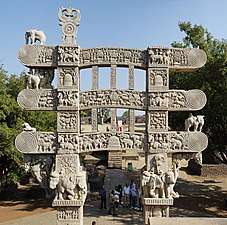

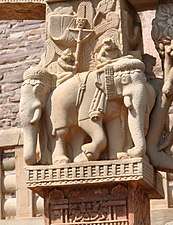
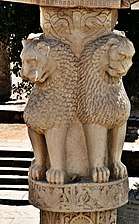
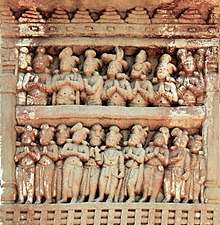
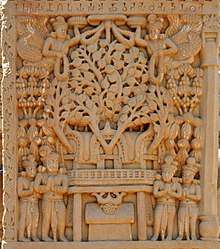
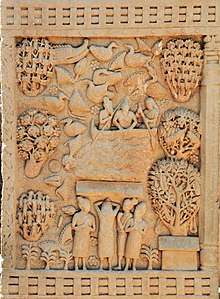
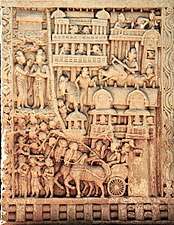
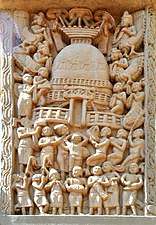




_without_national_boundaries.svg.png)